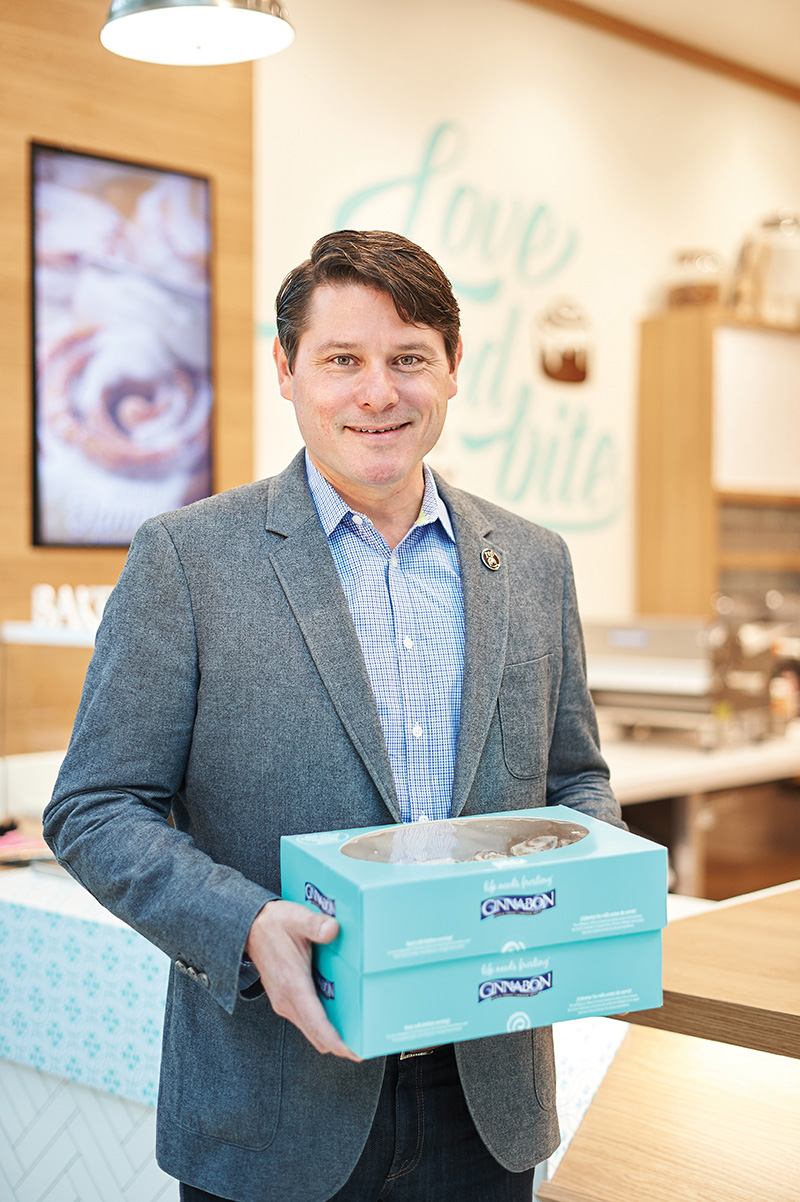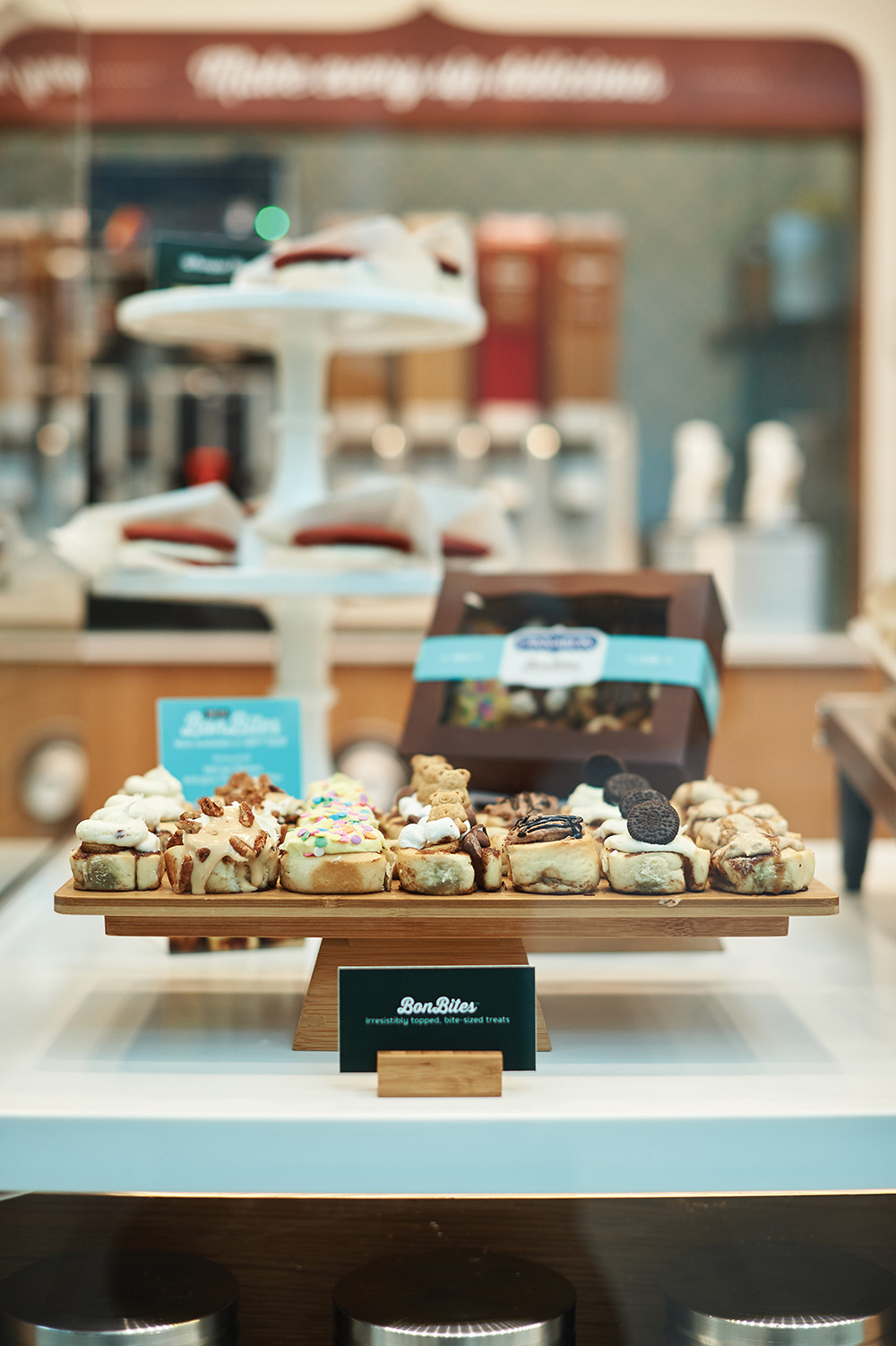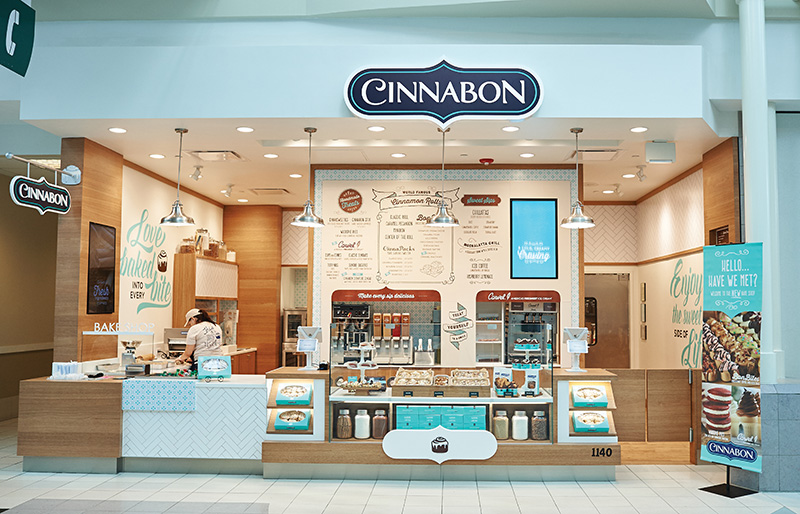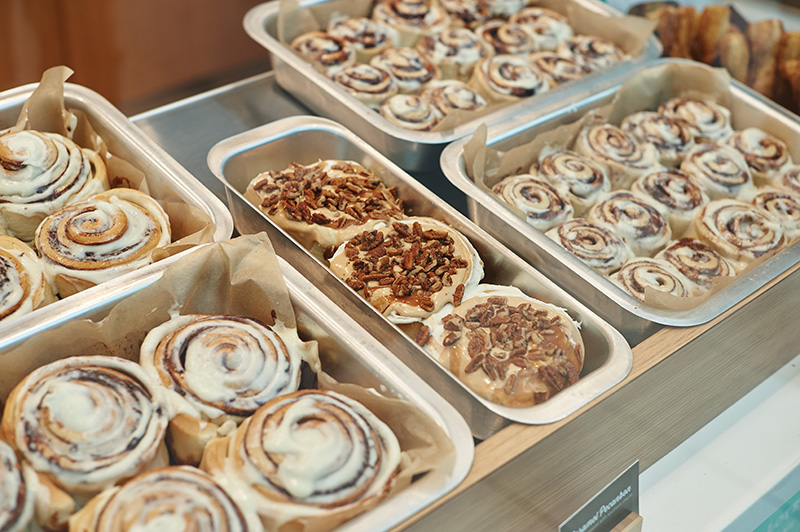Shopping mall veteran Cinnabon sweetens the deal for franchisees, landlords and customers with a hot new prototype and lucrative licensing.
By Katie Lee
Cinnabon is on a roll. The famous cinnamon roll franchise, whose presence in shopping malls has been a mainstay for nearly 30 years, is sweetening its deal. With a new store prototype exciting landlords, franchisees and customers alike, plus an aggressive push to grow its licensed products business, brand awareness for Cinnabon has never been higher — 95% — and is truly the icing on top.
Retail 101
Taking advantage of brand momentum, the company plans to parlay its household name and more than $800 million in 2015 retail sales to remodel approximately 40 locations this year and open an undisclosed number of new stores domestically and abroad. Cinnabon also has unveiled a new logo for the first time in 15 years.
 “A lot of what we’ve done is a page from the book of Retail 101,” says President Joe Guith. “[Retailers] have cool fixtures and they look great, but they’re not putting in real hardwoods — they’re laminate, but they look good. It’s the ‘Disney effect,’ if you will. We took a lot of cost out of the back of the store and put it into the front; this new unit actually costs the same as the old. We didn’t blow the budget.”
“A lot of what we’ve done is a page from the book of Retail 101,” says President Joe Guith. “[Retailers] have cool fixtures and they look great, but they’re not putting in real hardwoods — they’re laminate, but they look good. It’s the ‘Disney effect,’ if you will. We took a lot of cost out of the back of the store and put it into the front; this new unit actually costs the same as the old. We didn’t blow the budget.”
The new look is fast and flexible. Store team members can change digital menu boards and marketing screens swiftly, as well as pull down magnetic menu boards and replace them with ease. Painted murals can be changed out like windows. The new bakery case is more flexible to accommodate smallwares if merchandising needs a change.
“We can change the whole look of the bakery for a couple thousand bucks,” Guith says. “And be like a retailer versus ‘I’ve got to remodel the whole thing because everything’s done in fixtures and finishes that were supposed to last forever’ — but the reality is, in today’s world, you can’t build a unit and let it sit for 10 years and hope that it’ll be relevant by the end of its life. It’s just not going to work that way.”
The overall concept design is cleaner, lighter and more contemporary but also warm, inviting and textural. Graphics are simpler, more up-to-date and more lifestyle-oriented. “It’s embracing all that we were but updating it,” Guith says. “Reaction has been overwhelmingly positive.”
Baking the Brand
The first Cinnabon opened in December 1985, selling only the Cinnabon Classic roll — a recipe that was perfected by chef Jerilyn Brusseau, the “culinary wizard who brought Cinnabon to life,” according to Guith. The first franchise store opened in August 1986 in Philadelphia, followed in 1991 by Cinnabon’s first non-mall location at the Detroit Metropolitan Wayne County Airport.
 “It took off for 5 to 6 years — and then there was an Atkins Diet, a change in ownership, and lack of investment in the brand,” Guith says. “It kind of went into a downward spiral.”
“It took off for 5 to 6 years — and then there was an Atkins Diet, a change in ownership, and lack of investment in the brand,” Guith says. “It kind of went into a downward spiral.”
In 2004, Atlanta-based FOCUS Brands Inc. purchased the brand . Ten years later, Guith, with more than 20 years of experience in foodservice, consumer products and retail, joined Cinnabon as chief operating officer before being promoted to brand president in January 2015. Previously, Guith had worked with The Coca-Cola Company, Molson Coors Brewing Company and Staples, Inc. His prior roles were in general management and strategy with Coca-Cola and YUM! Brands in domestic and international markets. Guith notes his work with Coca-Cola and YUM! helped prepare him for the brand-focus strategy at Cinnabon.
“Brands have always been an important focus, but there’s definitely been a shift in terms of us becoming more of a brand-building company,” he says. “Cinnabon, from a retail sales standpoint, is our largest brand [of FOCUS Brands] and growing very steadily in all channels — licensing and franchising — and all geographies. We’re very fortunate.”
Guith and his team began by stripping the brand down to basics and asking the question, “What makes people want to come to Cinnabon?”
“We looked at life drivers, human motivations. They have a similar thing at Coca-Cola. Where does your brand sit? There’s a sense of belonging. When people think about Cinnabon, they think about baking, home, time with family, going to the mall with friends. That was a new insight for us. We started to think, ‘How do we continue to evolve that and turn it more into an experience in and around those ingredients, this different, updated Cinnabon?’”
Inspired by a European pâtisserie — a type of French or Belgian bakery that specializes in pastries and sweets — and a modern home kitchen, Cinnabon’s new concept aims to fuse the two and evoke a feeling of home and hearth along with sweet, savory indulgence. “We put a ‘home’ spin on the French pâtisserie, which makes it more down to earth,” adds Guith.
And then there’s the aroma. It’s critical, Guith says, to be able to smell Cinnabon products as they bake. Many franchisees position their stores specifically with aroma in mind. According to Guith, inline mall spaces do best; the aroma stays concentrated and is not able to waft away in different directions.
 Most Cinnabon stores average about 600 square feet, and high-traffic real estate is key. “We’re an impulse brand, not necessarily a destination brand, so we have to be where the people are. It’s about capture rate of existing traffic in malls,” Guith says. “If we’re off track or down the hallway, it’s not going to work as well. We also don’t work as well when we’re buried in the food court. We do work on the edge of the food court — I’ve seen that work incredibly well.”
Most Cinnabon stores average about 600 square feet, and high-traffic real estate is key. “We’re an impulse brand, not necessarily a destination brand, so we have to be where the people are. It’s about capture rate of existing traffic in malls,” Guith says. “If we’re off track or down the hallway, it’s not going to work as well. We also don’t work as well when we’re buried in the food court. We do work on the edge of the food court — I’ve seen that work incredibly well.”
Today Cinnabon is in 234 malls, and, as Guith notes, there remain about 800 viable malls that Cinnabon has on its radar. “So as we look out on the landscape, we know there’s going to be a reconciliation — anywhere from 15% to as high as 30%, I’ve heard. No one knows exactly,” he says. “Our benefit is we’re only in a third of those to begin with, so now as we start to grow much more rapidly, we know where the centers are that are going to be around after the chips fall. Malls aren’t going away.”
Cinnabon is active in non-traditional mall locations as well. Though not located in as many airports as it used to be, the company still has 15 of its original 150 airport locations. Locations inside travel plazas and existing restaurants are two real estate avenues seeing growth for the brand. “Our partnership with Pilot/Flying J has been very successful. We currently have more than 150 units with them,” Guith says. Recently, Cinnabon partnered with Schlotzsky’s (a fellow FOCUS brand) to open express bakeries inside more than 200 Schlotzsky’s locations. “We’re going to continue to push,” Guith adds. “We do well in airports, but we have maybe a tenth of what we had at our peak. Even though people associate us with airports.”
A License to Sell
Beyond its 1,350 franchise locations in 54 countries, Cinnabon also has expanded into grocery-store products by partnering with packaged-food kings Pillsbury and Kellogg’s. Additionally, the company has ramped up its presence in other restaurant chains by teaming up with fast-food leaders Burger King and Taco Bell. In 2014, Cinnabon developed a doughnut product for Taco Bell called Cinnabon Delights, and initially launched Cinnabon Minibon rolls in more than 7,000 Burger King locations when the Minibon rolls first came out. The bite-sized Minibon rolls don’t require a knife and fork. “While we know people love Cinnabon and always will, the challenge is finding new versions of it that may be more accessible or permissible.”
Last year, Cinnabon raked in $800 million in retail sales, and 70% of that was through licensing.
 Cinnabon is growing sales through a recent investment in new operational technology, too. In streamlining its new store prototype, one of the first things to go was the traditional point-of-sale (POS). Instead, Cinnabon has partnered with Revel and Apple to launch an iPad-based point-of-sale.
Cinnabon is growing sales through a recent investment in new operational technology, too. In streamlining its new store prototype, one of the first things to go was the traditional point-of-sale (POS). Instead, Cinnabon has partnered with Revel and Apple to launch an iPad-based point-of-sale.
“It takes less space, it’s more relevant to guests, and it’s more relevant to team members (it’s easier to train them),” Guith says. “It isn’t just a register — our franchisees will be able to do labor management and hourly planning for scheduling; we’ll be able to manage the production flow and make sure we’re keeping up with sales. It’s not like other food concepts — Cinnabon takes 1 hour and 10 minutes from the time you’re rolling, baking and pulling it out of the oven, so you’ve got to stay ahead of it.”
In addition to point-of-sale, production management and labor management, the new iPad-based system will also enable the company to go 100% paperless by year-end. “Everything will be on the iPad,” Guith says. “And by the way, all of that costs less than the old point-of-sale. We’re excited.”
As Cinnabon locations continue to update to the new POS, the remodel schedule also pushes forward. “It’s going to be another year or two before we’re done,” Guith says. “Then we’ll push the technology platform to the next level. That will be Phase II for Cinnabon.”
With so much brand-building momentum, developers are taking a second look at Cinnabon. “You get this upward momentum for the business. Remodels are a huge part of this. They help us do more than just build a better-looking bakery. The new technology and new look go hand in hand and continue to bring in great operators.”
— This article originally appeared in the May 2016 of Shopping Center Business and on the cover of the July 2016 issue of Retail & Restaurant Facility Business. Email the editor at [email protected].
